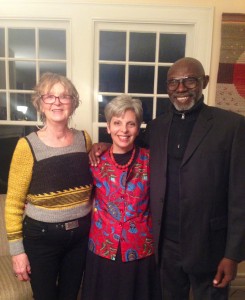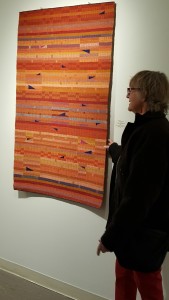The Topanga Public Library recently added Enamored With Place:As Woman+As Architect
to its collection
Mel Cross, a resident of Topanga generously hand delivered the book to the library.
Architectural Museum Library adds Enamored With Place to its collection
Recently generously hand delivered to the librarian by Diane Chehab
tp://www.dam-online.de/portal/de/Bibliothek/Start/0/0/0/0/1591.aspxA
Hedderichstraße 108-110
60596 Frankfurt am Main
Interview of weaver Wendy Bertrand by Kevin Janssen for Loom & ShuttleSeptember 2017 Newsletter
About Sibila Savage Photography
Are You Ready for Your Close-up?
There comes a time in an artist’s life when the need for professional photographs of their work becomes necessary because those self-snapped pictures from one’s phone or camera don’t seem to capture the colors, vitality or complexity of one’s work. Frequently, specific file formats and sizes are mandated for entry submissions to gallery shows and competitions; file requirements that outstrip the capabilities of those ubiquitous cell phones or small cameras.
Recently, Wendy Bertrand reached such a point in her work when she submitted an entry to (and was selected for) the International Fiber Arts VIII Exhibition at the Sebastopol Center for the Arts last month. (Please see the July 2017 Guild Newsletter for details.) Submitting an entry to the Fiber Arts VIII Exhibition was the final straw for Wendy in creating her own images and she began a search to educate herself about identifying and then working with a professional photographer to capture the essence, spirit and detail in her work in file formats she can then use going forward when presented with a venue or opportunity in which she’d like to enter her work. Generously, she is willing to share her experience with the Guild for those in a similar situation.
Once the decision was made that she needed professional photos, Wendy searched the Internet for information on professional photographers with experience in working with art made with fiber as well as seeking the advice and comments of others fiber artists. She came across several recommendations for Sibila Savage Photography. She contacted Sibila and had such an enjoyable conversation via phone that she decided to move forward and book an appointment to have several of her rugs photographed. Of great importance for Wendy was that she felt comfortable and confident with the person behind the camera.
She arrived at Sibila’s Emeryville studio and felt confident from the onset. She felt Sibila was genuinely interested in the pieces she brought into the session and worked with Wendy during the photoshoot to ensure she captured images that Wendy was satisfied with and would feel comfortable using. During the photoshoot, and after studying a specific piece, Sibila made suggestions for areas to capture in detailed shots that Wendy hadn’t thought of as Sibila approached her work with the sensibilities of an artist and not merely taking pictures with no thought or appreciation of the subject at hand. Sibila took a picture and invited Wendy to review the image on a monitor with her and welcomed comments and reactions to what they were viewing together that lead to adjustments in approach or changes in direction and/or lighting that resulted in photos that Wendy felt captured her work perfectly. Upon completion of the shoot, Sibila prefers to retain the art pieces for a few days for final tweaking of the images to insure colors are true and the images speak for the piece(s) directly.
Of importance for Wendy was to obtain photos in various formats that she would be able to use as needed. These formats embraced a print-ready format, digital formats and formats specific for entry submissions typical of most art calls. Wendy appreciated that she received all of the final formats electronically for each piece that was photographed. For each piece she brought to the session, she received a full-view and detail photo.
Wendy was so pleased with the experience of working with Sibila and the files she received that she is planning on scheduling another session to photograph additional work not included in her initial session. Not only does Wendy have images at the ready for when she writes an article for various publications, she is now poised with images in various formats to use when submitting her work for inclusion in gallery shows and competitions that show her work to great advantage. She was quick to mention that when sending in an application for any venue, there is a single opportunity to make an impression. Making the most of that opportunity means one needs to have great photos that represent your work as you wish others to see it.
An unplanned benefit from creating these professional photos is that Wendy now has images that document her work for her personal archives. She feels the investment in these images is well worth the price in that she can easily and confidently meet submission requirements and not have to scramble to satisfy entry file format requirements.
All my carpets have names. City Life was named about a forth of the way into the weaving when I became aware that weaving in San Francisco felt differently from weaving in my Gasquet Studio in rural Del Norte County. The lengths of time I found to weave were shorter, time and thoughts seemed more complex, intellectual, and fragmented.
This book shows the growth of the carpet and a few of the earlier carpets. Many of the yarns are natural dyed and about 65% of the yarns are hand spun. The rug is 62 inches by 40 inches. City Life is the first of a series of four carpets called Paying Attention inspired from the lectures of Belgium Philosopher Isabelle Stenger.
40 full color pages


Many exception works of fiber art. A MUST SEE SHOW
July 28, 2017 until September 3, 2017
Wendy Bertrand among artists in International Fiber Arts 8 Promo
Opening was a fabulous experience. Here I am with Loom and Shuttle Guild members Marlene Golden and Barbara Nitsburg.

62 inches H X 42 inches W


 Wendy Bertrand, Diane Chehad, Epee Ellong
Wendy Bertrand, Diane Chehad, Epee Ellong
This book attempts to answer the African architect’s constant professional dilemma—respecting the concept of “modern African” architecture, whereas Africans do not wish to live in traditional-style huts any longer.
Epée Ellong, with Diane Chehab, follow traditional African architecture through various historical phases to today’s African architecture, so as to highlight contradictions through a societal and technical lens.
The illustrations and images that accompany the text show the construction phases of traditional and contemporary architecture, as well as everyday objects. Many historical and linguistic references are used in order to better explain the changes on both a human and architectural level.
Subjects covered in the book include:
Why was this book written? There are few books that explain the relationship between history, colonization, sociology and architecture in Africa.
The authors:
Epée Ellong is a native of Douala, Cameroon. He is an architect trained at the Ecole des Beaux Arts in Paris, France. In 1983, he founded an architectural firm, CAEE, with his spouse, Diane Chehab, an American-born architect. The philosophy behind CAEE was to reincarnate African traditional architecture into modern design. A home whose basic materials are bamboo and palm fronds, and no electricity or running water, can’t be automatically transformed into a contemporary dwelling. Epée drew upon traditional symbolism and masks to “Africanize” CAEE’s architecture. The firm designed projects in Cameroon, Guinea, and Ivory Coast.
CAEE’s projects brought Epee to many parts of Cameroon, where he was familiarized with the country’s ethnic, cultural and geographic diversity. He met many regional traditional chiefs who provided him with the background of the architectural and social upheavals brought on by the arrival of Europeans. Together with these chiefs, he put together a nomenclature of the typological elements of traditional construction.
Epée has been practicing architecture in the United States since 1995. He has also taught Afro-centric architecture within specialized workshops, and speaks at American universities and at the Museum for African Art in New York.
Diane Chehab was born in the United States, lived in several countries and continentbads, and studied architecture at the Lebanese University in Beirut and at the Beaux Arts in Paris, France. She married her colleague, Epée Ellong, and moved to Cameroon to manage their architectural firm. She learned Duala, her spouse’s language, to better understand the culture. She currently shares her time between the United States and Cameroon.
The book is published by Riveneuve Editions, Paris. It can be purchased on Amazon.com in the United States.
The English edition is not out yet, but the French edition is bursting with photos and sketches and one learns, again, the importance of culture in architecture.
New blog by Virginia Tech special collections of the International Archive of Women Architects archivist Winn about the lived experiences of Women Architects includes Wendy Bertrand’s memoir Enamored with Place: As Woman + As Architect and Inge Horton, local author … Continue reading
October 28,2016 at Auto Desk, Wendy Bertrand donates copies of her memoir :Enamored with Place:As Woman+As Architect to support theme of opening event encouraging AIA Equity by Design Conference goers to tell their stories.

Books for Equity by Design attendees

Wendy Bertrand third from left with jacket by Lola of SF

16 Triangles during end of show talk

Global Warming during end of show talk

Global Warming Handspun and commercial wool yarn on linen warp 60 X 42 inches
Carpets/ Wendy Bertrand
Reporting (edited) on Woven Together by Wendy Bertrand
News Release Woven Together: Experience & Expression
A Loom & Shuttle Guild Members’ Exhibition
January 13 – February 12, 2017
Reception: 7-9 PM Friday, January 13, 2017
Sanchez Art Center / East Gallery 1220-B Linda Mar Blvd., Pacifica, California
Gallery hours: Friday, Saturday, & Sunday 1–5 pm (starting January 14, 2017)
An exhibition of handwoven and handcrafted textiles, Woven Together: Experience & Expression, will be shown in the East Gallery of the Sanchez Art Center in Pacifica, California, from January 13, 2017 thru February 12, 2017. Art pieces, fashion, sculpture, wearable art, weaving for the home, and fine craft made by members of the Loom and Shuttle Guild will be displayed, reflecting a wide range of techniques and skills. Items include woven scarves, shawls, bags, jackets, table runners, tapestries, baskets, carpets, and stitched textiles. Items will be available for purchase.
The Loom and Shuttle Guild, a San Francisco weaving guild founded in 1948, draws participants from all over the San Francisco Bay Area. Members come not only from textile, fine art, and fashion careers, but from a diversity of fields such as music, teaching, technology, graphic design, writing, architecture, nursing, law, science, and more. Many artists have been weaving for decades, and many exhibit their work in local and national exhibits. New members continue to join the guild and expand their knowledge about the art and craft of weaving.
The guild’s purpose is to promote high standards of weaving, to stimulate public interest and appreciation in handweaving and fiber art, and to offer educational opportunities. Demonstrations of weaving, spinning, and braiding will be scheduled periodically throughout the exhibit, and posted on the Loom and Shuttle website.
Open to all, this free exhibit highlights the ancient craft of handweaving still practiced today. There is ample free parking and the Sanchez Art Center is wheelchair accessible.
For the Conference of Northern California Handweavers: www.CNCH.org
For gallery information: www.SanchezArtCenter.org